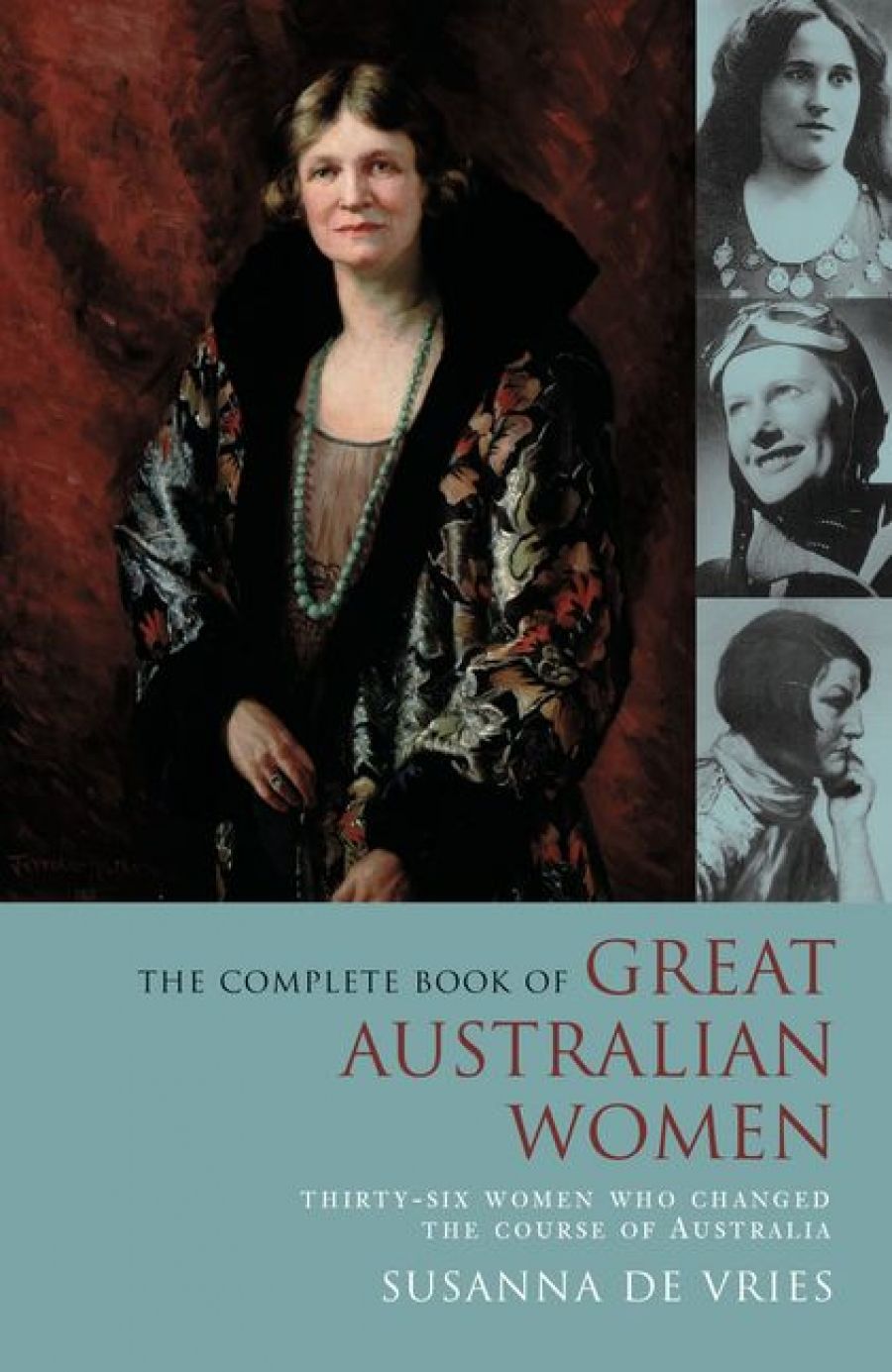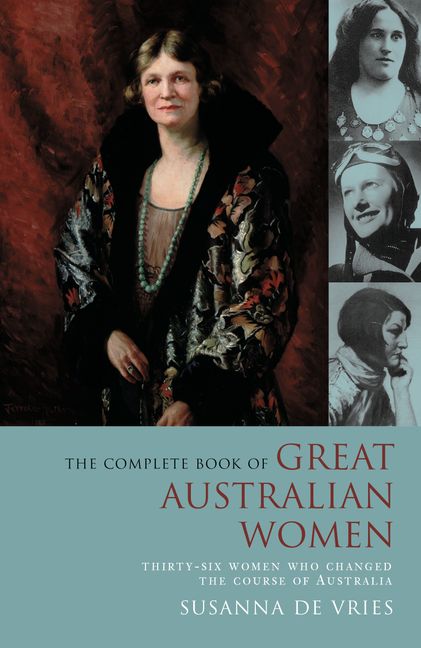
- Free Article: No
- Contents Category: Non-fiction
- Review Article: Yes
- Article Title: An Exclusive Club
- Online Only: No
- Custom Highlight Text:
If it is inadvisable to judge a book by its cover, perhaps it is equally unreliable to judge one by its title. But The Complete Book of Great Australian Women set my teeth on edge before I’d turned the first page. What qualifies a woman for greatness? Great deeds? Great courage? Great neighbours? And wasn’t the point of feminist history not only to open up the list of historical actors but also to challenge the very principles of historical gatekeeping: professional merit, political influence, public stature? The subtitle certainly doesn’t contribute to more inclusive notions of historical agency and achievement. Like a human hydroelectric scheme, de Vries’s women struggle to overcome the many ‘natural’ barriers to female success, and, like the nation itself, emerge triumphant.
- Book 1 Title: The Complete Book of Great Australian Women
- Book 1 Subtitle: Thirty-six women who changed the course of Australia
- Book 1 Biblio: HarperCollins, $35 pb, 670 pp
- Book 1 Cover Small (400 x 600):

- Book 1 Cover (800 x 1200):

And complete? How can a book that depicts thirty-six women whose lives span over one hundred and fifty years lay any claim to comprehensiveness (even if it does run to a whopping 650 pages)? Familiar names such as Edith Cowan and Roma Mitchell are there – Kylie Tennant and Miles Franklin, Nellie Melba and Margaret Preston, too. Lesser lights such as Dagmar Berne (‘pioneer woman doctor’) and Florence Taylor (‘Australia’s first female architect’) get a look-in. There’s even a nod to indigenous women with the inclusion of Oodgeroo Noonuccal and Ella Simon. But what about Dawn Fraser? What about … (insert your own pet heroine here)? All the women profiled in this book did lead fascinating, complex lives, and there can be no doubt that they performed acts of social, political and cultural significance, demonstrated excellence, and achieved hard-won prominence in their chosen fields of endeavour.
The problem with alleging totality is that, when the postmodern impulse fancies multiplicity over monopoly, you are certain to alienate major sections of your readership from the outset. Apart from one Jewish barrister (Joan Rosanove, ‘Jewish by race rather than religion’), no women of Asian or other ethnic origin are included; Anglo-Celts only need apply for membership of the Great Women club. But de Vries is not attempting to curry favour with a left-liberal intelligentsia for whom giving voice to diversity is the aim of much contemporary scholarship and artistic expression. De Vries’s constituency is the heartland of relaxed and comfortable Australia, where discrimination is but a memory in ‘our less prejudiced age’. Here, female pioneers – such as Fanny Durack, who defied regulatory bodies and sexual conventions to become the first female swimmer to win an Olympic gold medal – can now proudly epitomise ‘that happy Australian characteristic of “giving it a go”’. Devoid of any meaningful analysis of class, sectarian or race dynamics, the forces that conspire to police boundaries and protect territory are relegated to the foreign country of the past. Though, as with many military historians and sports biographers, de Vries’s methodology (trailblazers, precursors) seems peculiarly dated, she has definitely found her political moment.
To be fair to the author, the title of her book is likely to have been selected by her publisher as a convenient marketing tool. The Complete Book is an amalgam of two works previously published by HarperCollins: Great Australian Women One (2001) and Great Australian Women Two (2002). Both have been ‘bestsellers’, and de Vries has clearly located an audience for her cosy intermingling of populism and feminism. As a sampler, this ‘complete’ book offers neither new re-search nor a fresh perspective on familiar material. Its ample notes– a remarkable inclusion in a publishing era when even eminent scholars tussle with their editors to retain such an economically irrational indulgence – reveal that many of the women included are the subject of full-length biographies, essays and memoirs. The book works best as a sort of extended Who’s Who, introducing readers to a host of captivating female writers, artists, activists and innovators. But whether through lack of editorial guidance or resources, there has been a missed opportunity here. In bringing together two volumes and, patently, years of painstaking research, this book offered the chance to draw a bigger picture about the historical and personal circumstances that shaped the lives of certain important Australians – an occasion to draw distinctions or resonances between the women whose experiences display such extreme richness and complexity.
The introduction provides little more than a dot-point summation of ‘the heart-warming stories’ that follow, and there is no attempt to link the chapters, either by narrative or analytical means. Excessive generalisation and repetition are the result; for example, we are told with numbing regularity that in the nineteenth century married women were the legal property of their husbands and that the twentieth century was ‘a male chauvinistic era’. Conversely, de Vries’s disjointed approach tends to overlook the finer evidence of women’s subjectivity as they grappled with poverty, children (or childlessness), legal restrictions and social mores to achieve recognition in male-dominated professions. Many of the individuals, we are told in passing, suffered ‘depressive illness’, but this euphemistic clue is never explored in any sustained way.
Though de Vries maintains a tone of exasperated disbelief at the injustices faced by women in the past, hers is a kind of Laura Ashley indignation: ‘Doctors claimed that … women should not study hard or it might affect their menstrual periods, making them infertile. An absurd theory, but at the time, people believed it.’ Written in cloying and affected prose (‘Joe and Enid felt themselves to be in love’; ‘Agnes was desolated’), the women’s lives are presented in the manner of a girls’ own annual, replete with tragic and untimely deaths, ‘primitive’ conditions, unsuitable suitors, jealous rivals and pretty, sweet-natured sisters.
Owing more to melodrama than to Freud, de Vries’s psychological insights into women’s motives for their uphill battles are often shallow. When Edith Cowan’s father, Kenneth Brown, is found guilty of murdering his wife and hanged for his crime, ‘his execution brought sensitive, retiring Edith face to face with the realities of death … in those days there was no bereavement counselling’. Such childhood deprivations in-variably lead to a lifelong commitment to ‘the poor and disadvantaged’. Attempts to sketch historical context are just as clumsy and clichéd, exemplified by this description of the gold rush era: ‘a great turning point, the period that changed Australia from a penal settlement into a thriving rough-and-tumble male-dominated society linked by the concept of mateship.’ This schizophrenic blend of righteous ire and progressivist pride results in some bizarre assertions: Dagmar Berne, we are told, was a ‘martyr to male prejudice’. In fact, she died of tuberculosis in 1900 at the age of thirty-five. What ultimately elevates de Vries’s women to greatness is: ‘They all helped to make Australia what it is today.’ (And believe me, there is no hint of irony when de Vries tells us that Edith Lyons’s parents were ‘hard-working, decent folk who had been brought up to despise the Irish and distrust everything Catholic’.)
Unfortunately, de Vries’s jingoistic stereotypes under-mine the remarkable qualities of the stories themselves and the author’s own extraordinary achievement in amassing such a wealth of biographical information. Yes, the women depicted do exhibit amazing powers of resourcefulness, endurance, and fortitude (along with their thinly veiled depression, snobbery and racism). But why limit these human qualities to national borders, claiming them (the good bits, that is) as ‘distinctly Australian attributes’? While I am a devotee of making history accessible and enticing to wide audiences, this book plays it too safe. With so much original, edgy research into women’s history struggling to find a publisher, it is a pity that this blandly pre-digested and packaged work should take up so much space. Then again, perhaps you can judge a book by its title.


Comments powered by CComment